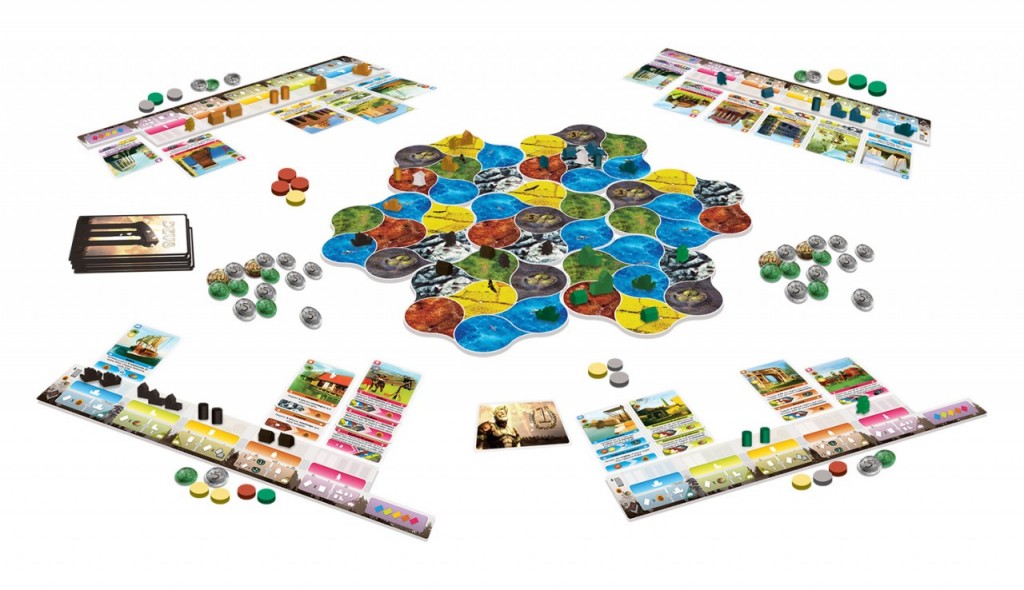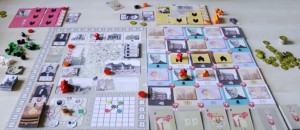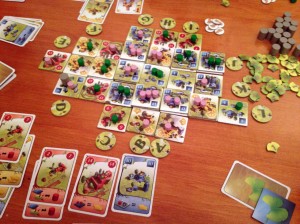Posted by James (admin) on 23rd September 2014
 Deus is a game by Sébastien Dujardin (co-designer of Troyes and Tournay). It’s a game of ancient civilisation building, whilst trying to appease the gods, and contains some interesting sounding game mechanics.
Deus is a game by Sébastien Dujardin (co-designer of Troyes and Tournay). It’s a game of ancient civilisation building, whilst trying to appease the gods, and contains some interesting sounding game mechanics.
The board is made up of a number of hex tiles (well, they’re kind of rounded-off hexagons) which contain 7 regions on each consisting of 4 land regions (producing wood, stone, wheat and clay), 2 water regions, and 1 barbarian village. The layout on each tile is slightly different, and the tiles are placed together randomly each game giving some variety in replay.
Each player has a player board showing 6 coloured columns which each relate to a type of wooden building: civil, scientific, maritime (ships), military (armies), production, and temple. You start with some buildings on each column, cash, Victory Points (VPs), resources, as well as drawing 5 building cards from the common deck.
Each turn is simple: You can either construct a building, or make an offering to the gods. Read the rest of this entry »
Tags: board game news, Board Games, board gaming, Deus, Essen, Pearl Games, Sébastien Dujardin, Spiel 14, Spiel 2014
Posted in Board Games, Deus, Essen Spiel 14, Preview, Spiel 2014 | No Comments »
Posted by James (admin) on 9th September 2013

Image of prototype from Cliquenabend’s preview video. Click on the image to watch the video.
Bruxelles 1893 is a worker placement game with lots of game mechanics going on. The setting is that players architects who are building Bruxelles in 1893. The board is divided into two areas: the Bruxelles board and the Art Nouveau board.
Worker placement on the Bruxelles board locations is free (no coins); however, if a player wants to place on a location occupied by another worker, they must place one more worker than those already there; however, these extra workers go to jail/court when the player takes the action. So, you can potentially use any action on the Bruxelles board but it may cost you workers. The locations for workers on the Art Nouveau board is a grid and players must add coins to their workers when placing there. The players with the most total coins in a column at the end of a round takes that column’s bonus card which can be used for either an instant bonus or saved for an end of point scoring effect.
The 5 actions are: gain resources for building, build a building, create a work, sell a work, and gain a character. The income from selling a work (I believe a mix of cash and points) is based on the position of a marker on a grid – the income a player receives is based on the marker’s position and is adjusted by which player you are too. So, changing the income marker’s position shifts all player’s potential income mix. The resources required to build a building are determined by a dial and you can turn the dial after you construct a building. Gaining characters gives a bonus but there’s a cost at the end of the game if you also keep the character. Read the rest of this entry »
Tags: board game news, Board Games, board gaming, Bruxelles 1893, Essen, Pearl Games, Spiel 13, Spiel 2013
Posted in Board Games, Bruxelles 1893, Essen Spiel 13, On the Radar, Spiel 2013 | No Comments »
Posted by James (admin) on 13th November 2012

Ginkgopolis is by one of the designers I really like – Xavier Georges (Carson City, Royal Palace, Troyes and Tournay). Ginkgopolis is a game with the theme of futuristic, city building. As with many of Georges’ games, the game mechanic is a bit unusual (it’s actually relatively simple, although it may not seem so at first). As a result, I felt it important to explain the gameplay quite clearly (so please excuse the length of this review) because a brief outline would offer little insight.
GAME
At the start of the game, there are 9 building tiles in a 3×3 grid – 3 red, 3 yellow and 3 blue buildings with values 1, 2 and 3 – surrounded by lettered discs A-L. The initial card deck contains cards for each letter and each of the 9 starting buildings. Players start with some resources (cubes) of their own colour and some building tiles. During the game, the players will add building tiles to the 3×3 grid (on the outside as well as laying new tiles on top of existing ones). Players score victory points (VPs) when placing some tiles, and at game end for controlling areas plus bonus VPs based on cards they own. The player with the most VPs at the end of the game wins. Read the rest of this entry »
Tags: board game news, Board Games, board gaming, Essen, Ginkgopolis, Pearl Games, Spiel 2012, Xavier Georges, Z-Man Games
Posted in Board Game Review, Board Games, Essen Spiel 12, Ginkgopolis | No Comments »
 Deus is a game by Sébastien Dujardin (co-designer of Troyes and Tournay). It’s a game of ancient civilisation building, whilst trying to appease the gods, and contains some interesting sounding game mechanics.
Deus is a game by Sébastien Dujardin (co-designer of Troyes and Tournay). It’s a game of ancient civilisation building, whilst trying to appease the gods, and contains some interesting sounding game mechanics.


